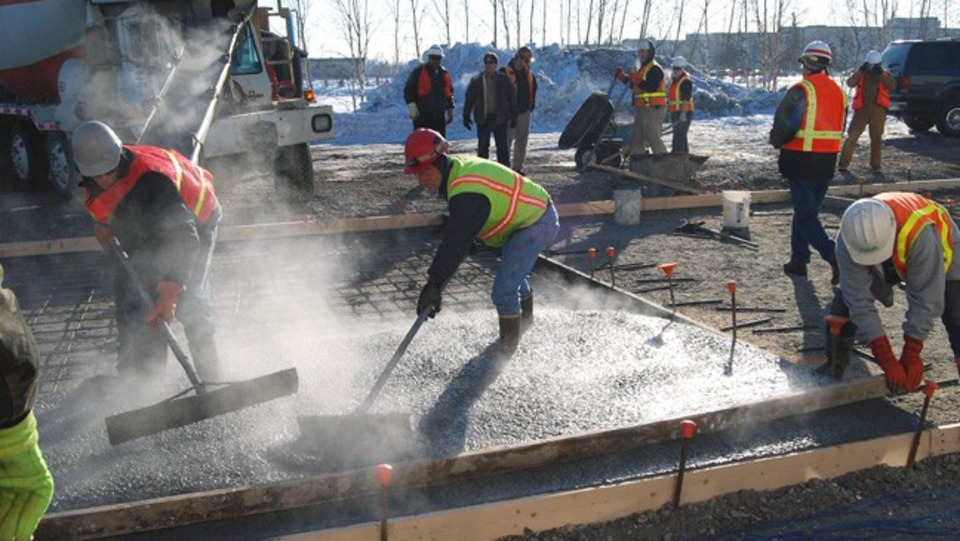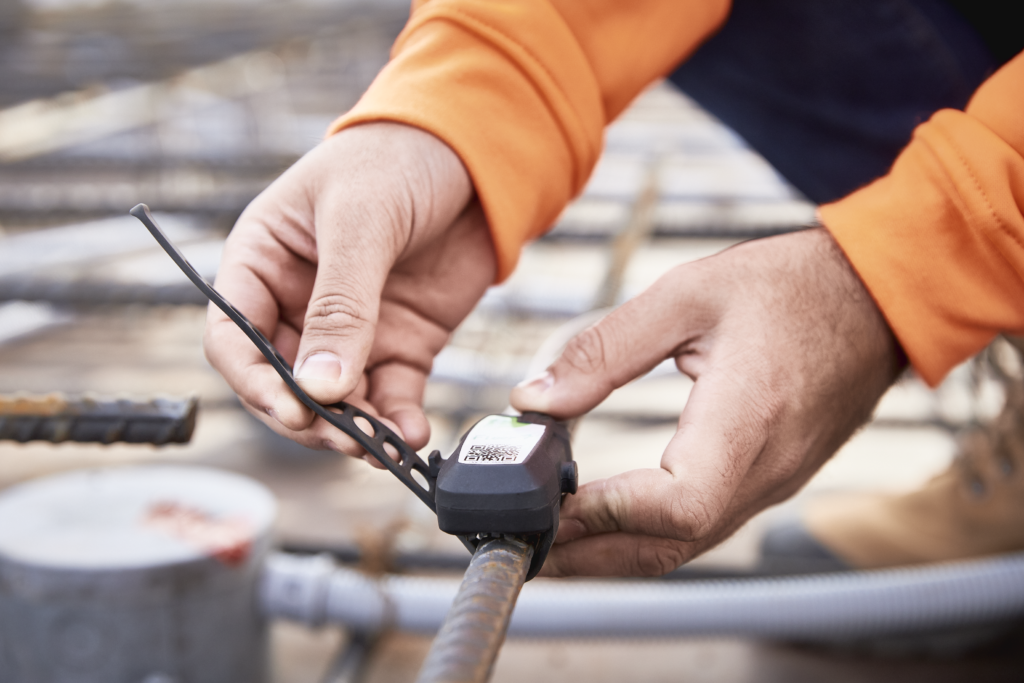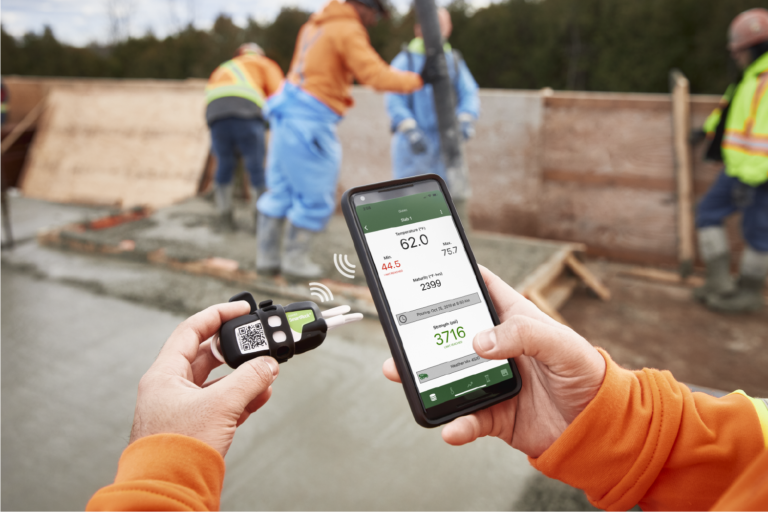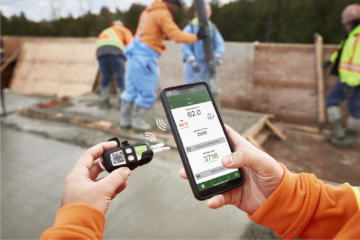Monitoring your concrete curing temperature during the early stages of construction ensures the integrity of your structure. This is especially true during extreme weather conditions when mixing and curing of concrete are subject to different environmental elements. If freshly poured concrete is exposed to temperatures that are too high or too low, or if it isn’t preserving enough moisture, the strength development of the concrete will be compromised. Thus, closely monitoring temperature variances in your concrete slab during curing is vital to ensuring strength, quality, and durability. Using a concrete curing thermometer is the best method in ensuring the integrity of your concrete structure.
Explore 12 Futuristic Technology Trends Solving Concrete's Biggest Challenges.
How to Control Concrete Temperature During Mixing and Curing
There are multiple methods to lessen the adverse effect of improper hydration temperatures. To control the temperature during the dormant and strength-gain phases of the hydration process, there are two possible approaches.
The first approach is to optimize the mix design. The second approach is to control the surrounding elements or curing properties that influence the temperature. These can also be combined.
Controlling Concrete Temperature During Mix Design
To maintain the desired temperature during heat of hydration (an exothermic reaction in cement), you need to design your mix to fit the specific application and ambient conditions of the concrete. Here are some things to consider when designing your concrete mix:
- Selecting the appropriate cement type changes the amount of heat generated. Compared to Type I cement, Type III generates more heat. Type II generates moderate heat, and Type IV generates less than the others.
- Adjusting the finesse of the cement (i.e. using a finer cement) will generate more heat.
- Using supplementary cementitious materials (SCMs) effectively reduces the heat generated during hydration. Replacing a portion of the cement with slag or fly ash reduces the amount of reactive material in the early stages. In turn, this reduces the amount of heat generated and delays concrete strength gain.
- Adding other types of admixtures such as retarders and accelerators can help control the length of the dormant period. However, these mixtures will not typically affect heat generation.
Learn how concrete temperature monitoring fits into your project
Why Proper Concrete Curing Temperature Is Important
Concrete curing helps maintain moisture content and temperature levels in early-age concrete so that it can reach its specific mix strength. Having the right amount of moisture in the concrete is important because the chemical reaction known as hydration tends to dry out the concrete due to the loss of heat. When concreting in extreme weather (hot or cold) there are specific measures to take in order to ensure the integrity of your concrete structure.
Hot-Weather Concreting
A general rule of thumb with hot-weather concreting is to maintain a limit of 70°C (160°F) for concrete curing temperature during hydration. If the temperature of the concrete during hydration is too high, it will cause the concrete to have high early strength development. But, consequently, gain less strength in the later stage. This results in lower durability of the structure overall. Such temperatures also interfere with the formation of ettringite in the initial stage, but it can happen in the later stages which causes an expansive reaction and subsequent cracking.
Cold-Weather Concreting
In the American Concrete Institute (ACI) 306: Guide to Cold Weather Concreting “cold weather” is defined as three or more consecutive days of low temperatures, specifically outdoor temperatures below 40°F (4°C) and air temperature below 50°F (10°C) for more than any 12-hour period. In cold-weather concreting, when the ambient temperature is too low, the hydration of the cement will drastically slow down or even completely stop until the temperature increases again. The general guidelines suggest that the concrete curing temperature must be maintained at >5°C (40°F) for 48 hours (ACI 306).
How Extreme Weather Affects Concrete

One of the ways to avoid overheating your concrete in hot weather is to schedule your pours at night when external temperatures are lower. Another technique is to use cold water in the mix or to cool aggregates down with ice.
In cold weather, the temperature can be managed using external heating systems in order to control curing conditions. Extreme curing temperatures can also be managed in mass pours by using cooling pipes.
Hot-Weather Concreting Tips
- To cool concrete, use ice or liquid nitrogen as part of the concrete water mix.
- Avoid placing concrete at noon as temperatures tend to be highest during that time of day.
- Use cool water to dampen side forms for slabs or walls.
- Keep an evaporative retarder ready on-site in case the temperature rises, and water starts evaporating rapidly.
- If hot weather is likely to occur during the concrete placement, use a large size of coarse aggregate particles. The larger aggregates minimize the probability of having concrete shrink due to environmental conditions.
Cold-Weather Concreting Tips
- Monitor the concrete curing temperature within the first 24 hours to ensure in-situ concrete temperatures do not drop more than 4° C (40° F).
- Frozen fresh concrete during the first 24 hours can lead to 50% loss of its potential 28-day strength.
- Maintain concrete curing temperature above 4° C for at least four additional days after the use of insulation blankets or heated enclosures.
- Maintain concrete curing temperatures above 10° C (50° F) for three to seven days by using fresh concrete.
- Never pour concrete over frozen ground, snow, or ice. Use heaters to thaw the ground before pouring concrete.
Curious About Monitoring Temperature in Extreme Weather? Click here!
The Most Efficient Tool to Monitor Concrete Curing Temperature
The process of placing and curing concrete on site requires precise temperatures so as to not damage the structural integrity of the concrete. With SmartRock, a wireless concrete curing temperature thermometer, you no longer have to worry about ambiguous wait times and faulty break tests. SmartRock delivers real-time, accurate data to your mobile device every 15 minutes. The free app calculates the data of your in-situ concrete, eliminating guesswork.

As a completely wireless sensor, SmartRock allows contractors to work efficiently without worrying about protruding wires. The sensor is fully embedded in the concrete and secured on the rebar within the formwork. This means you do not need to search for wires under heating blankets or rely on any external data loggers to collect or send data. With the touch of a button, you can download the free application and share data with your team instantly!
SmartRock’s ability to monitor the effects of the in-situ concrete and ambient temperatures makes it easier to control concrete curing and ensure optimal conditions. In addition, real-time results allow contractors to optimize the heating process, decrease energy costs, and save time in their project schedule by knowing when to move on to subsequent construction operations, such as formwork removal or post-tensioning. With the ASTM C1074 maturity method, SmartRock sensors can estimate the in-place strength of concrete.
Learn More About the Benefits of SmartRock Sensors Now!
Sources:
Tips and Recommendations for Pouring Concrete in Hot Weather
Learn How to Pour Concrete in Cold Weather
Concrete in Practice
Concrete Construction
**Editor’s Note: This post was originally published on December 19th 2018 and has been updated for accuracy and comprehensiveness.










